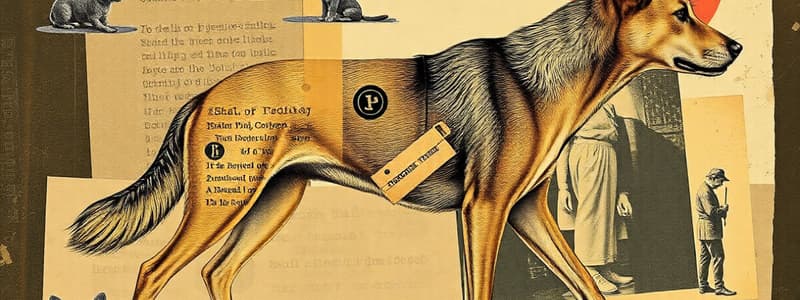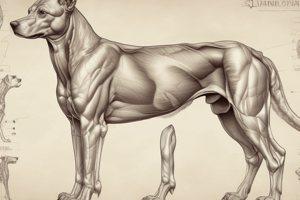Podcast
Questions and Answers
Which of these canids is considered to be the closest relative to the domestic dog?
Which of these canids is considered to be the closest relative to the domestic dog?
- Coyote
- Jackal
- Wolf (correct)
- Fox
What is a key characteristic of a domesticated animal compared to its wild counterpart?
What is a key characteristic of a domesticated animal compared to its wild counterpart?
- A longer muzzle relative to its body.
- Retention of juvenile behavioral traits. (correct)
- A rougher coat.
- Increased size and stronger teeth.
Which of the following best describes the process of domestication?
Which of the following best describes the process of domestication?
- The taming of individual animals from the wild.
- The forced breeding of wild animals to produce a specific genetic outcome.
- The isolation of a group with a decrease in human contact and interaction.
- The geographic, reproductive, and behavioral isolation of a selected group from the wild population. (correct)
What is the primary difference between a 'tamed' animal and a 'domesticated' animal?
What is the primary difference between a 'tamed' animal and a 'domesticated' animal?
Which dental characteristic is shared by all members of the order Carnivora?
Which dental characteristic is shared by all members of the order Carnivora?
Which of the following is a characteristic of the family Canidae?
Which of the following is a characteristic of the family Canidae?
What is the primary function of the elongated canine teeth in carnivores?
What is the primary function of the elongated canine teeth in carnivores?
What does it mean if a species is described as 'interfertile'?
What does it mean if a species is described as 'interfertile'?
Which of the following best describes the Miacids?
Which of the following best describes the Miacids?
Which of these species has not undergone the extensive structural and size changes seen in the domestic dog?
Which of these species has not undergone the extensive structural and size changes seen in the domestic dog?
What is the general walking style of the Miacids?
What is the general walking style of the Miacids?
What best describes a cat's social behavior in relation to humans as described in the provided text?
What best describes a cat's social behavior in relation to humans as described in the provided text?
Which lineage is considered the oldest ancestor of the domestic cat?
Which lineage is considered the oldest ancestor of the domestic cat?
Which of these is NOT a characteristic common to all cats within the Felidae family?
Which of these is NOT a characteristic common to all cats within the Felidae family?
According to the provided content, which wild cat species is found in the widest variety of habitats?
According to the provided content, which wild cat species is found in the widest variety of habitats?
What is the scientific name for the oldest member of the Canidae family, as mentioned in the provided text?
What is the scientific name for the oldest member of the Canidae family, as mentioned in the provided text?
What is the approximate range for when the domesticated cat appeared alongside humans, according to archaeological evidence?
What is the approximate range for when the domesticated cat appeared alongside humans, according to archaeological evidence?
What likely attracted wild cats to human settlements in ancient Egypt?
What likely attracted wild cats to human settlements in ancient Egypt?
What is a significant difference between adult domestic cats and adult wild cats regarding social behavior?
What is a significant difference between adult domestic cats and adult wild cats regarding social behavior?
How did the change in human consciousness regarding hygiene impact the perception of cats?
How did the change in human consciousness regarding hygiene impact the perception of cats?
Which of the following best describes how dogs were selected during domestication in comparison to wolves?
Which of the following best describes how dogs were selected during domestication in comparison to wolves?
What was the likely initial purpose of domesticating cats during their early relationship with humans?
What was the likely initial purpose of domesticating cats during their early relationship with humans?
During what period were cats associated with pagan religious practice and witchcraft?
During what period were cats associated with pagan religious practice and witchcraft?
What key characteristic of domestic dogs helps them adapt to new enviroments, that is not seen similarly in wolves?
What key characteristic of domestic dogs helps them adapt to new enviroments, that is not seen similarly in wolves?
What is the primary difference in reproductive cycles between domestic dogs and their wild counterparts, wolves?
What is the primary difference in reproductive cycles between domestic dogs and their wild counterparts, wolves?
What was the main factor that favored the development of proto-dogs around human settlements?
What was the main factor that favored the development of proto-dogs around human settlements?
What is a key behavioral difference observed between domestic dogs and wolves when greeting humans?
What is a key behavioral difference observed between domestic dogs and wolves when greeting humans?
What is the significance of the 5-12 week period in the life of a domestic dog?
What is the significance of the 5-12 week period in the life of a domestic dog?
How does the development of wolf pups compare to domestic dog puppies in their first few weeks?
How does the development of wolf pups compare to domestic dog puppies in their first few weeks?
How does the socialization of a wolf, even in captivity, compare to that of a domestic dog?
How does the socialization of a wolf, even in captivity, compare to that of a domestic dog?
What evidence supports the theory that dogs were domesticated after humans developed settlements?
What evidence supports the theory that dogs were domesticated after humans developed settlements?
Which of the following behaviors is observed in domestic dogs as adults but only in wolves as puppies?
Which of the following behaviors is observed in domestic dogs as adults but only in wolves as puppies?
Flashcards
Order Carnivora
Order Carnivora
Both cats and dogs belong to this order, characterized by specialized teeth for tearing and shearing prey.
Carnassial Teeth
Carnassial Teeth
Large, specialized teeth found in Carnivores, used for shearing and tearing prey.
Incisors
Incisors
Small, sharp teeth used for holding prey.
Canine Teeth
Canine Teeth
Signup and view all the flashcards
Miacids
Miacids
Signup and view all the flashcards
Hesprocyon
Hesprocyon
Signup and view all the flashcards
Viverines
Viverines
Signup and view all the flashcards
Dinictis
Dinictis
Signup and view all the flashcards
Commensal Relationship
Commensal Relationship
Signup and view all the flashcards
Domestication
Domestication
Signup and view all the flashcards
Utilitarian Domestication
Utilitarian Domestication
Signup and view all the flashcards
Spiritual Domestication
Spiritual Domestication
Signup and view all the flashcards
Cat Migration
Cat Migration
Signup and view all the flashcards
Cats and Witchcraft
Cats and Witchcraft
Signup and view all the flashcards
Selective Breeding
Selective Breeding
Signup and view all the flashcards
Subordinate Behavior
Subordinate Behavior
Signup and view all the flashcards
Canidae Family
Canidae Family
Signup and view all the flashcards
Interfertile
Interfertile
Signup and view all the flashcards
Taming
Taming
Signup and view all the flashcards
Domestication vs. Taming: Cats
Domestication vs. Taming: Cats
Signup and view all the flashcards
Taxonomy
Taxonomy
Signup and view all the flashcards
Phylogeny
Phylogeny
Signup and view all the flashcards
Communication Methods
Communication Methods
Signup and view all the flashcards
Proto-dog tolerance
Proto-dog tolerance
Signup and view all the flashcards
Increased reproduction in domestication
Increased reproduction in domestication
Signup and view all the flashcards
Dog-human bond
Dog-human bond
Signup and view all the flashcards
Socialization period for dogs
Socialization period for dogs
Signup and view all the flashcards
Wolves and human bonds
Wolves and human bonds
Signup and view all the flashcards
Dog greeting behavior
Dog greeting behavior
Signup and view all the flashcards
Wolves and aggression
Wolves and aggression
Signup and view all the flashcards
Study Notes
Course Information
- Course name: Canine and Feline Compendium
- Course code: AVS 3333
- Instructor: Jennifer Hoose, DVM DACVECC
- Office hours: Tuesdays and Thursdays, 10 am - 11 am, Building 94, room 269
Course Structure
- Four sections, each with an exam at the end
- Exams are multiple choice and true/false, completed on Scantrons
- Exams can be reviewed during office hours
- Textbooks: "The Dog" and "The Cat"
- Syllabus outlines chapters assigned to each section
- Final exam is cumulative
- Five exams, each counting for 20% of the final grade
Phylogeny (Canine)
- Canidae family includes dogs, wolves, coyotes, dingoes, foxes, and jackals
- Wolves are considered the dog's closest relative (dogs, wolves, coyotes, and jackals are interfertile)
- Dogs and wolves have comparable communication methods
- Dogs are better at responding to human social cues
- Wolves show less aggression when hunting, but more towards other pack members when hurt
- Domestic dogs are naturally less dominant than wolves
Phylogeny (Feline)
- Cats belong to the Felidae family
- Characteristics common to all cats: rounded head, flexible body, excellent balance, speed, hearing, and eyesight, proficiency in detecting movement
- Wild relatives include: African Wildcat, European Wildcat, Jungle Cat, Pallas Cat, and Sand cat
- Taxonomy of the domestic cat: Kingdom - Animalia, Phylum - Chordata, Class - Mammalia, Order - Carnivora, Family - Felidae, Genus - Felis, Species - catus
- Domestication of cats began 3,000-5,000 years ago, and was initially associated with Egyptian granaries
- Cats were initially utilitarian for rodent control, spiritual in Egyptian beliefs.
- Cats were later associated with pagan religion and witchcraft, leading to torture and killing
- Modern cats maintain a juvenile behavior pattern, needing socialization while still capable of being semi-wild
Phylogeny (Both)
- Miacids are an ancestral group to both dogs and cats (time of dinosaurs)
- Viverines branched into 2 lines: Smilodon (large cats, sabertooth tiger), and Dinictis (ancestor of domestic cats)
- Miacines gave rise to Hesprocyon, evolved in North America, digitgrade (walking on toes) and evolved into Leptocyon, and then Tomarctus, evolving the behaviors of modern day dogs (canids).
- Domestic cats have not undergone the significant structural changes seen in domesticated dogs. Felis Catus is still considered domesticated but not a tamed species.
Domestication (General)
- Breeding and containment of large animal groups
- Geographic, reproductive, and behavioral isolation from wild populations
- Results in genetically distinct animals with new characteristics relative to original wild species
- Includes "taming" which is decreasing fear of humans
Domestication (Cats)
- Cats have a protected status due to rodent control and cultural associations
- Cats are still recognized as a very important part of human life
- Cats exhibited a high level of hygiene even though they come from wild populations
Domestication (Dogs)
- Adaptable to new environments
- Selected for puppy-like trust of new stimuli
- Wolves show dominance, but dogs show subordinate behaviors
- Dogs have a better adaptation from wolves in regards to interactions with humans
General questions
- Should wild animals, like cats, wolves, or hybrids be allowed as pets?
Studying That Suits You
Use AI to generate personalized quizzes and flashcards to suit your learning preferences.




